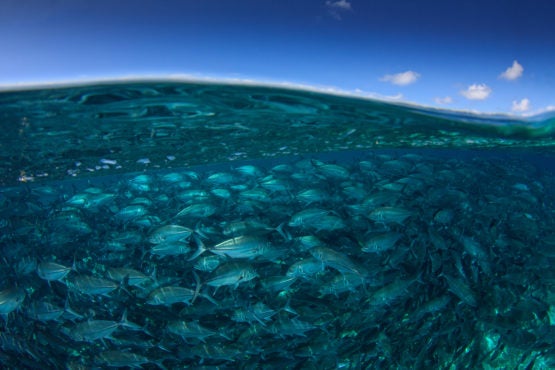June 2, 2020
Stanford experts highlight oceans’ role in solving food insecurity
Our growing need for food poses one of the biggest threats to the environment. Stanford ocean and food security experts explain how the ocean could produce dramatically more food while driving sustainable economic growth.
A key to solving global hunger – which is predicted to intensify during the COVID-19 pandemic – may lie in the ocean. In fact, the ocean could produce up to 75 percent more seafood than it does today, and drive sustainable economic growth, according to Stanford’s Rosamond Naylor and Jim Leape.

Fish in the sea at Sipadan Island, Malaysia. (Image credit: Adobe Stock)
Stanford Report spoke with Leape, co-director of Stanford’s Center for Ocean Solutions, and Naylor, the William Wrigley Professor in Earth System Science, about how global food policies can better integrate “blue foods” from marine and freshwater systems, how to address gaps in current thinking, and what world leaders can do to create a healthier, more sustainable food system.
The researchers are part of a major global initiative called the Blue Food Assessment, which is the first comprehensive review of aquatic foods and their roles in the global food system. Naylor will discuss the initiative on June 3 at the Virtual Ocean Dialogues, an online gathering of business, government and public sector leaders who are invested in creating a more resilient ocean.
How has the current pandemic affected “blue foods?”
Naylor: Aquatic food is, by far, the most highly traded food commodity. COVID-19 is disrupting processed and widely traded seafood products, such as salmon, shrimp and tuna. The collapse in passenger travel has largely shut down markets for fresh and frozen tuna, for example, because they are shipped in passenger flights. However, locally produced and consumed food systems are actually faring much better. This is especially true for some small-scale fisheries, where local fishing groups have taken the initiative to sell seafood locally and new markets are emerging during the COVID-19 period. Production and consumption have become more tightly connected as a result. Local food markets and seafood sharing activities have surfaced, for example, in indigenous communities along the British Columbian coast, in Oaxaca, Mexico and in Hawaii.
Leape: With a growing and increasingly prosperous population, we are seeing a rapid growth in demand for animal protein. Increasing production of beef would have dire environmental consequences – livestock already accounts for nearly 80 percent of land devoted to agriculture and is a major source of greenhouse gas emissions. Increasing production of aquatic foods has been appealing because it has the potential to have a lower environmental impact; it can also be healthier. But the details matter – there are more than 2,100 species of fish, both wild-capture and farmed – and the nutritional value of seafood and its environmental impacts depend hugely on the species and how it is harvested.
What are the most important changes we can make, in terms of policies and practices to shape the future of the aquatic food system?
Leape: About 20 percent of the world’s fish catch is stolen each year; in some of the places that depend most on fisheries, that proportion reaches 30 or 40 percent. Illegal fishing defeats efforts to manage the resource sustainability and cheats the fishers who are playing by the rules. And we can end it. Emerging technologies are bringing much greater transparency into the fishing industry. There is growing momentum among major governments and companies to use these capabilities to ensure that illegal fishers have nowhere to land their catch and no one to buy it.
What are some innovations that hold particular promise for a more sustainable food system?
Leape: Rapidly expanding satellite capabilities are allowing an increasingly granular picture of what’s happening on the water – so we can track vessels, and tell when they are fishing where they shouldn’t be, for example. Soon this will be complemented by onboard electronic monitoring – video cameras on vessels and even on nets, with AI algorithms that allow rapid detection of problems like overfishing and catching protected species.
Naylor: For seafood, it has been exciting to see big innovations in feed sourcing for carnivorous finfish and crustaceans. The aquaculture industry is using novel materials like microalgae, insect feeds and terrestrial plant-based materials – including many by-products from commercial crops – in their feed ingredients. This is taking pressure off wild fisheries that are used to produce fishmeal and fish oil. Advanced genetics are now being used to enhance fish growth, reduce the consumption of wild fish in feeds, and promote better disease resistance. If we want healthy oceans in the future, we have to be thinking about a wide range of innovations, and the institutions, financial incentives, and public trust needed to turn these innovations into real market solutions.
Leape is also the William and Eva Price Senior Fellow at the Stanford Woods Institute for the Environment. Naylor is the William Wrigley Professor of Earth System Science; Founding Director of the Center on Food Security and the Environment; Senior Fellow in the Stanford Woods Institute for the Environment and the Freeman Spogli Institute for International Studies.
-30-
|